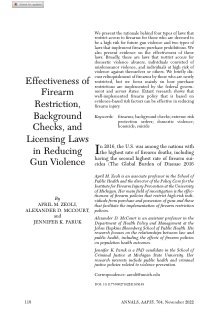By Kristen Rand. Additional research was provided by Kaya van der Horst
Fifty caliber sniper rifles are used by militaries around the world and can penetrate armor plating and shoot down aircraft on take-off and landing, but can be purchased under federal law in the U.S. as easily as a single-shot hunting rifle. The study’s release comes the day before the U.S Supreme Court will hear oral arguments by the government of Mexico in its lawsuit against gunmaker Smith & Wesson, another manufacturer of military bred weaponry utilized by the cartels.
VPC Government Affairs Director Kristen Rand states, “Fifty caliber sniper rifles are the guns most coveted by the cartels and most feared by Mexican law enforcement. The VPC has warned for years about the unique threat these anti-materiel guns present. Now they are being used to inflict maximum harm in Mexico. The U.S.-based manufacturers of these weapons must be held accountable.”
The VPC joined other gun violence prevention organizations in an amicus brief in support of the government of Mexico. The VPC has issued a wide range of studies on the threat posed by 50 caliber sniper rifles, including the risk they pose in the U.S. to infrastructure, civil aviation, and national security.
The study details the history of the Barrett, manufactured in Murfreesboro, Tennessee and the original 50 caliber sniper rifle, the gun’s unmatched combination of firepower and range, and the use of it and other 50 caliber rifles in numerous attacks and assassinations by Mexican cartels. Data contained in the study reveal that from 2010 to February 2023, the majority of 50 caliber sniper rifles (519 of 831) recovered by Mexican authorities were Barretts. Barrett and other 50 caliber sniper rifles have also been obtained by terrorists around the world, including Al Qaeda. In addition, the study:
Cites numerous reports and research warning of the terror threat posed by the easy accessibility of 50 caliber sniper rifles, including: compromising command and control via assassination; the threat to aircraft (including civilian airliners); and, infrastructure.
Offers numerous examples of terrorist and other criminal acts, including assassination, involving 50 caliber sniper rifles in Mexico, the U.S., and around the world.
Details how the use of armor-piercing rifle rounds can further magnify the power – and the threat – of these deadly weapons.
Includes profiles of companies manufacturing 50 caliber sniper rifles.
The study also puts forth policy recommendations including a federal ban in the United States of these uniquely destructive firearms.
Washington, DC: Violence Policy Center, 2025. 34p.





















